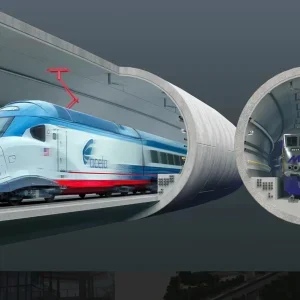The first 1.2km long drive for the first line of the new metro system in Kazan, the capital city of the national republic of Tatarstan in Russia, has holed through. The 5.7m diameter Lovat TBM, bought specifically for the project in April 1997, broke through into the open-cut station reception area on 17 August 2001 after starting from the launch station box in May 2000.
Since breaking through, the TBM back-up has been retrieved back through the completed drive and the shield has been transported back to the starting station and reassembled ready to start the parallel 1.2km drive by a planned date of 20 September 2001.
This first pair of 1.2km long tunnels are the first of eight Lovat TBM drives to link four open-cut station boxes on the initial 8.7km long metro section. The 18m deep tunnels run through saturated ground. A final section to a fifth underground station to the south of the line through dry competent ground will be excavated using an open faced, excavator shield. This section is yet to start.
After deliberately taking 15 months to complete the first Lovat drive under an area of few surface buildings for a knowledge gaining learning curve, the Kazmetrosstroy construction team plans to achieve a realistic advance rate of about 250m/month on the next and future drives.
Together with the first application of modern EPB tunnel excavation through the wet, soft material, the engineers of the project claim several additional technology firsts for tunnelling in Russia. For the first time the project is using a tapered precast concrete segmental lining. The 1m wide rings of the bolted and gasketed one-pass lining comprise seven segments, plus a key, and a Tacs guidance system on the TBM predicts the necessary orientation and sequence of the segments in each ring to negotiate the compound curves on the line. The high specification annular grout, injected immediately behind the lining as each ring leaves the tail skin will eliminate the need under Russian metro tunnelling specifications to caulk the segment lining joints and carry out secondary contact grouting. It will also allow the bolts in the lining to be removed and reused. The process of having these advances approved by central tunnel construction specification authorities in Moscow is under way.
This initial section of the City’s first metro line is programmed to be opened in August 2005.







